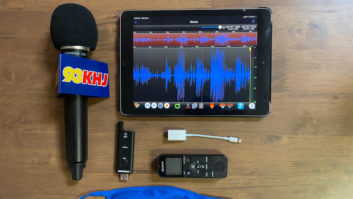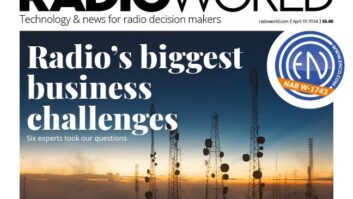Field Report: Olympus LS-10
May 1, 2008 12:00 PM, Rubin I. Garcia, CBT CBNT
I like to think that some of the functions of a broadcast technician are to supply options and solutions to problems. When it comes to capturing audio in the field, the Olympus LS-10 recorder is a problem solver and another option for broadcasters. Released in January 2008, the LS-10 is a must-have in any facility. Naturally, production people will love the LS-10, but how about doing a simulated live broadcast? Why not produce segments on location and send them back to the station ready to air? I believe anyone can achieve this with this recorder.

First impressions
What sets the LS-10 apart from the other recorders can be seen the moment you take it out of the box. The outer case of the Olympus LS-10 is constructed from aluminum and fits nicely in the palm of your hand. Extremely lightweight, it weighs less than 6 ounces and is comfortable to use.
The low-noise stereo microphones are angled 90 degrees apart, making it much easier for the user to record questions and responses during interviews. This makes for better stereo separation as well. Included are two windscreens that snap firmly onto each microphone. Additionally, a zippered cloth carrying case with a storage pocket is supplied for easy transport. A wrist strap is also provided.
Once powered, the LS-10 comes to life with its large, well-lit, easy-to-read, back-lit LCD screen. All the menu navigations can be accomplished with one hand since the buttons are clearly labeled and ergonomically placed. The menu is extremely user friendly, simple to navigate and self-explanatory. Set the time, date and record levels and you are literally ready to roll.
Under the hood
Performance at a glance 24-bit/96kHz recording
Records WAV, MP3 and WMA formats
Internal 2GB storage
SD card slot for memory expansion
Built-in stereo mics and speakers
Camera tripod thread mount After playing with the LS-10 at my desk I began to think of ways I could use this device to make the station’s live broadcasts easier, and improve the quality of the audio being sent over the codecs. Like most stations in larger markets, I have produced live broadcasts from various locations, including the common car dealer, cruise ships and various Caribbean Islands. Most of the time we are able to get a good quality phone line but there are times when we have had to cancel a broadcast because of a poor connection.
The Olympus LS-10 also comes with Cubase LE4 software on a DVD. Cubase is a 48-track audio recording and production software with lots of plug-ins and effects. The LS-10 has a built-in reverb feature, and Cubase’s VST3 effects provide even more creative tools.
There are 2GB of built-in memory as well as an expansion slot for an SD card. Three recording modes are available: PCM, MP3 and WMA. Obviously, the recording time will depend on the chosen format, but more than 35 hours of audio can be recorded with the MP3 format.
Unfortunately, the LS-10 does not include XLR/TRS jacks, but there is a 3.5mm stereo microphone jack on the side. On-board, twin 16mm stereo speakers can be used to listen to recordings, or headphones can be plugged in (not included) for privacy. While we are on the subject of listening to a recording, the LS-10 can be used as an MP3 player and as an external storage device for a PC. What I’m really impressed with is that the LS-10 is compatible with Windows Media Player and Itunes.
The stereo line input jack (3.5mm) accepts a +6dBv signal. The mic input sensitivity is selectable with a side-mounted switch for high (59dBv) or low (39dBv) setting.
Road test
This is where having the Olympus LS-10 as an option — when you are miles away from the station and can’t get an ISDN line or dependable phone connection — can really save a broadcast.
Initially, I decided to send the LS-10 with our promotions team to obtain audio for station promos and interviewing winners. Keep in mind most of our promotions assistants are part-time help and new to broadcasting, so I was expecting some difficulty in them learning how to use the LS-10. Surprisingly, they had no problems. Learning how to use the LS-10 was a breeze. I was told that listeners seemed more willing to talk into the LS-10 than a large microphone with a microphone flag attached to it. Some listeners were intrigued with how it worked and its features.
To record, press the record button once. This arms the recorder, and a lighted ring around the record button flashes red. Press record again, and the ring stays red while the unit records.
Finally, the perfect opportunity arrived to showcase the ease and multiple uses of the Olympus LS-10. Our oldies station scheduled an anniversary cruise to various islands in the Caribbean and the question arose of how a broadcast could be done from the cruise ship or any of the islands? I suggested doing a simulated live broadcast. This would be accomplished by having our on-air personalities pre-record some of their breaks with the LS-10 during the cruise, interviewing the stars performing, recording some of the experiences from each of the islands, and sending all of this back edited and ready to be aired.
Olympus P
W 888-553-4448
www.olympusamerica.com The Olympus LS-10 offers 24-bit/96kHz linear PCM recording. You can capture studio-quality material in the palm of your hand. The USB connection cable (supplied) bridges the gap between the recorder and the production facility. The recorder runs on two AA batteries or an optional dc power supply. There is a camera tripod thread mount on the bottom. And because the unit can be mounted to directly record a performance, there is a connector for an optional infrared remote control receiver between the mics. With this, the recorder can be set up and recording started remotely.
Our PD loved the idea. It was an inexpensive solution and the sound quality could be controlled and edited. The client was ecstatic because every experience was captured. The on-air personalities were able to enjoy all the amenities without physical limitations (wires). The gods of Olympus have finally given the gift of the LS-10 to broadcasters.
Garcia is a broadcast technician at Lincoln Financial Media, Miami, FL.
Editor’s note: Field Reports are an exclusive Radio magazine feature for radio broadcasters. Each report is prepared by well-qualified staff at a radio station, production facility or consulting company.
These reports are performed by the industry, for the industry. Manufacturer support is limited to providing loan equipment and to aiding the author if requested.
It is the responsibility of Radio magazine to publish the results of any device tested, positive or negative. No report should be considered an endorsement or disapproval by Radio magazine.









